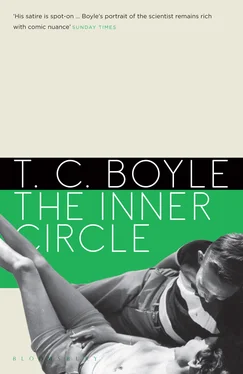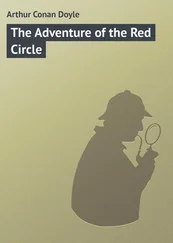I stood there hovering over him, incapable of decision — I didn’t even know if I could sit, if the muscles would respond or the factory of my brain issue the command. “Yes,” I murmured.
Iris’s mother was transformed, as inflated as I’d ever seen her — there was a celebrity in the house, the great man himself, parked on the sofa in her living room at 14 Albion Drive. “Tea,” she said, extending her smile even to me, “would you like some tea? And sweet buns, I have sweet buns—”
Prok, at his most courtly, in the voice that had mesmerized how many thousands I couldn’t even begin to guess, said that that would be very nice indeed, a real treat, and my mother-in-law practically fell at his feet. I wondered, even in my distracted state, how long it would take before she volunteered to give up her history.
I was on the verge of breaking in, of demanding to know where my wife and son were and why she hadn’t gone to get them, first thing, when suddenly the sound of the clarinet came drifting down from above, something hesitant, broken, infinitely sad, as if all the sorrows of humankind had been distilled to the single failing breath of that melody. “That’s Wagner,” Prok said. “The ‘Liebestod,’ isn’t it? From Tristan and Isolde ?”
“Honestly, I don’t know,” Iris’s mother said, throwing up her hands. “With Iris, it could be anything—”
And then I was gone, through the door and up the steps two at a time, and I didn’t care about Prok or the project or anything on this earth but her, Iris, my wife, the woman I loved and needed and wanted. I flung open the door and there was my son, sprawled out asleep in the middle of the bed as if he’d dropped down from the sky, and Iris at the window with her clarinet. She was wearing a pair of child’s slippers, fluffy and oversized, and a blouse that fed off the color of her eyes. She played two notes more, sostenuto e diminuendo, and then, very slowly, with infinite care, she laid the instrument aside and held out her arms. And can I tell you this? — I never let go of her, never once, never again.
Bloomington, Indiana
August 27, 1956
I’d like to be able to report that everything continued on an even keel, that Iris and I were able to make the necessary adjustments and live in harmony ever after — or until the present, at any rate — and that the project came to fruition and Prok received the recognition he deserved as one of the great original geniuses of the twentieth century, but in life, as distinct from fiction, things don’t always tie up so neatly. Iris never attended a musicale again, and she never again mounted the stairs to the attic at the house on First Street. She was present for the social occasions, the picnics, the occasional staff dinners at Prok’s, the holiday celebrations, but she saw them as an obligation, nothing more, and gradually she began to withhold her friendship from Mac and Violet Corcoran and Hilda Rutledge and take up with a new circle of people she’d known from her days at school, even talking about going back to teaching once John Jr. matriculates from the lower grades. In the interval, I’ve continued with the business of the Institute, with the interviews and the travels and the filming, sometimes as an observer, sometimes a participant. Iris and I don’t discuss it. I try to leave my work at the office, as they say. And Elster — Prok had him transferred back to the biology library the day we returned from Michigan City and he’s been persona non grata in Wylie Hall ever since. Good riddance, is what I say.
As for Prok, his life was too short. Dead at sixty-two, buried this morning. He wanted to record one hundred thousand histories — that was his grand ambition, the definitive sample — but at last count we had something less than twenty percent of that figure. And he projected another several volumes in the series to take advantage of all that raw data, a volume on sex offenders to follow the female, but everything is in flux now. His last words to me, as they bundled him off to the hospital, were: “Don’t do anything till I get back.” I don’t know. I’m too distraught right now to see things clearly, but if there was a catalyst in all this — in his exhaustion and the wear and tear on his heart that ultimately killed him — it was the female volume. Less than three years after its publication, he was dead.
Publishers are forever using the cliché “eagerly anticipated” to describe ordinary and humdrum volumes of which no one is even remotely aware, but I can say, without doubt, that Sexual Behavior in the Human Female was the most feverishly awaited and explosive title of the century. Everything that worked so spectacularly for the male volume — the marshalling of the press, the close-guarding of the proofs, the secrecy and vigilance — was redoubled for the female. During the months leading up to publication, Prok brought the press in for a series of lectures, meetings with the inner circle, long exhaustive face-to-face talks until late in the night, and, of course, a first look at the proofs and the signing of his standard contract limiting their articles to five thousand words and a proscription against publishing before August 20—1953, that is — which one wag had already dubbed “K-Day.” Excitement was so high, in fact, that we had to reschedule the publication date from the fourteenth of September to the ninth, because the retail outlets began putting the book on the shelves the minute they received their shipments, no matter the prohibitions and pleas from the Saunders Company. Predictably, sales were spectacular, outstripping those of the male volume by something like two to one in the first weeks.
But then, as I’m sure you’re aware, the adverse reaction set in. It’s not as if we didn’t expect it — Prok had warned us from the outset that the public would react very differently to revelations about female sexuality than to those regarding the male of the species, but that it was absolutely necessary that we publish our findings in any case, because, as he liked to say, people just had to learn to face reality. If the male volume was shocking, especially in regard to the statistics relating to pre- and extramarital relations and the prevalence of H-behavior, at least the general public had always viewed men’s sexual mores with some degree of skepticism, but to put women in the same category was something else altogether.
Whether Prok liked it or not, women had been placed on a pedestal — they were our wives, daughters, mothers — and people came to see the book less as a scientific survey than as an attack on American womanhood. They objected to hearing women called “human animals,” a phrase that recurs some forty-eight times in the text, and to Prok’s bias toward premarital sex as well (our statistics, as I informed Iris in the backseat of the Nash so long ago, showed that women who engaged in premarital sex were more likely to make a satisfactory adjustment to marriage than those who did not). In fact, they hated all our statistics and what they implied — that women were sexual beings too, 62 percent of whom had masturbated, while 90 percent had engaged in petting, 50 percent had had premarital intercourse and 3.6 percent reported sexual contacts with lower animals. Mothers and daughters having sex with animals (and never mind that only one of our subjects had experienced full coitus with her pet, a German shepherd, as I recall, and that our single highest rater had achieved no more than perhaps six hundred orgasms through oral-genital contact with her cat) — the notion alone was enough to inflame the public to almost universal condemnation of us, our methods, our objectives, personalities and characters. There were even stirrings among the legislators on Capitol Hill to the effect that Sexual Behavior in the Human Female played into the hands of the Communist menace that sought to destroy the moral fiber of the country.
Читать дальше












